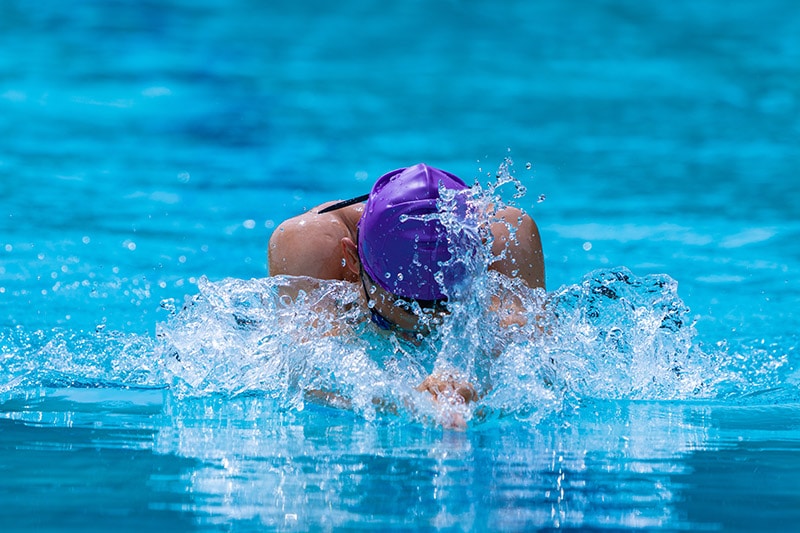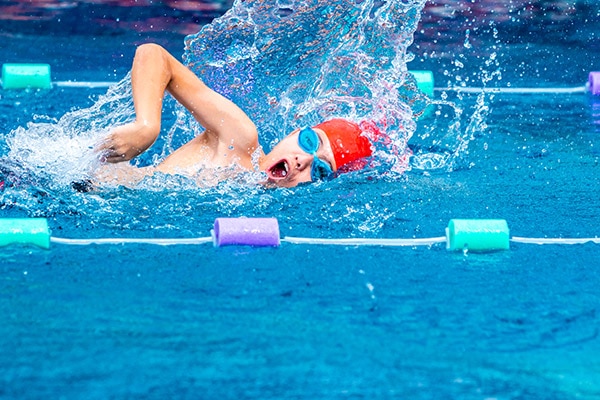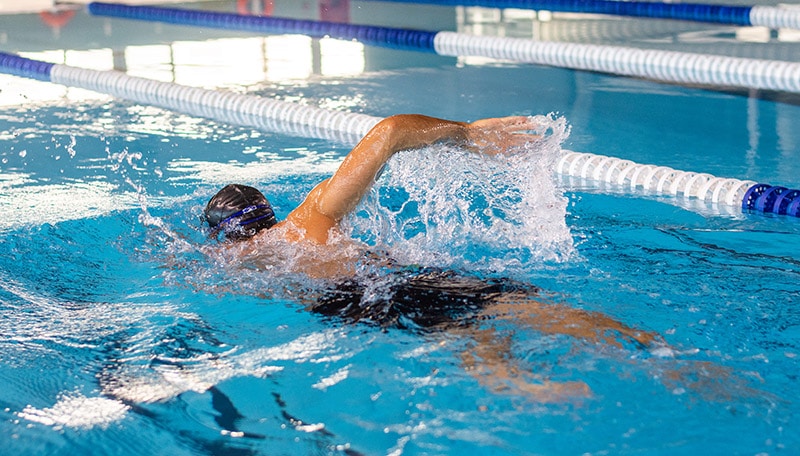Two of the most common swimming strokes are breaststroke and freestyle, but which one should you use?
Both strokes have their own unique characteristics and benefits.
Freestyle, also known as front crawl, is the most popular swimming stroke and is used in many competitions.
It involves a continuous flutter kick and alternating arm strokes.
The swimmer’s face is in the water, and they breathe by turning their head to the side during the arm stroke.
Freestyle is a fast and efficient stroke that can cover a lot of distance in a short amount of time.
Breaststroke, on the other hand, is a slower stroke that uses a frog-like kick and a simultaneous arm motion.
Swimmers keep their head above water during the stroke and breathe in through their mouth and nose.
Breaststroke is often used in recreational swimming and is a great option for beginners or those who want a low-impact workout.
Still not sure? Let’s look a bit closer at the differences between these two strokes so you can pick which one is right for your swimming style.
Overview of Breaststroke and Freestyle

Breaststroke and freestyle are two of the most common swimming strokes used in competitions and recreational swimming.
While both strokes involve moving through the water, they have distinct differences in technique and style.
Freestyle, also known as front crawl, is the fastest and most efficient of the four competitive swimming strokes.
It involves a continuous flutter kick and alternating arm strokes that pull the swimmer through the water.
The swimmer breathes to the side during each stroke, rotating their head to take in air.
Freestyle is often the first stroke taught to beginners because it is relatively easy to learn and can be used for long-distance swimming.
Breaststroke, on the other hand, is a slower and more technical stroke that involves a frog-like kick and a simultaneous arm pull.
Swimmers glide through the water with their arms extended in front of them, then pull their arms back to their chest while simultaneously kicking their legs out and around.
This motion propels the swimmer forward in a wave-like motion, and the swimmer takes a breath every stroke by lifting their head out of the water.
While freestyle is generally faster and more efficient than breaststroke, breaststroke is often preferred by swimmers who want to conserve energy or swim for longer distances.
Additionally, breaststroke is often used in medley races, which combine all four competitive swimming strokes.
Differences in Technique
Here’s a look at how these two swimming strokes differ just in their technique.
Arm Movement
One of the most notable differences between breaststroke and freestyle is the arm movement.
In freestyle, the arms move in a circular motion, with one arm pulling while the other arm recovers.
This motion allows the swimmer to move quickly through the water and generate a lot of forward momentum.
On the other hand, breaststroke involves a more complex arm movement.
The arms move in a half-circular motion, starting from the streamlined position and moving outwards and downwards.
The hands then sweep inwards and upwards, meeting at the chest before pushing forwards again.
This motion generates less forward momentum than freestyle but allows the swimmer to maintain a steady pace and conserve energy.
Leg Movement
Another key difference between breaststroke and freestyle is the leg movement.
In freestyle, the legs move in a flutter kick motion, with the feet pointed and the legs alternating up and down.
This motion generates a lot of forward momentum and allows the swimmer to move quickly through the water.
On the other hand, breaststroke involves a more complex leg movement.
The legs move in a whip kick motion, with the feet flexed and the legs moving outwards and backwards before coming together and propelling the swimmer forwards.
This motion generates less forward momentum than freestyle but allows the swimmer to maintain a steady pace and conserve energy.
Breathing Technique
The breathing technique is also different between breaststroke and freestyle.
In freestyle, the swimmer breathes to the side, turning their head to the left or right to take a breath while the opposite arm is pulling.
This allows the swimmer to maintain a steady rhythm and conserve energy.
On the other hand, breaststroke involves a more complex breathing technique.
The swimmer takes a breath as their arms are pulling inwards towards their chest, lifting their head out of the water and taking a breath before returning their face to the water.
This motion requires more energy than freestyle but allows the swimmer to maintain a steady pace and conserve energy.
How To Do The Freestyle Swimming Stroke

The freestyle stroke is one of the most popular swimming styles out there.
Here are the steps to perform the freestyle stroke correctly:
Step 1: Start in a horizontal position with your face down in the water, and your arms extended in front of you. Your feet should be together, and your legs should be straight.
Step 2: Begin by kicking your legs in a flutter kick motion while simultaneously pulling your arms down towards your hips. Your palms should be facing downwards, and your elbows should be bent at a 90-degree angle.
Step 3: As your arms reach your hips, rotate your body to the side, and take a breath. Your head should be turned to the side, and your mouth should be above the water level.
Step 4: While exhaling, extend your arms forward, and bring your face back down into the water. At the same time, your legs should continue to flutter kick.
Step 5: Repeat the process, alternating sides for breathing. Keep your body straight and streamlined to minimize drag and maximize speed.
It’s important to maintain proper form while performing the freestyle stroke.
Keep your head down and your body straight to reduce resistance in the water.
And make sure to exhale while your face is in the water to avoid inhaling water.
How To Do The Breaststroke
The breaststroke is a swimming stroke that requires coordination and proper technique to execute correctly.
Here are the steps to performing the breaststroke:
- Start in the streamline position: Begin by standing in the water with your feet shoulder-width apart. Extend your arms straight out in front of you, with your palms facing down and your fingers together. Your head should be in line with your spine, and your body should be straight and streamlined.
- Take a breath: Inhale deeply, and hold your breath as you prepare to begin the stroke.
- Perform the arm stroke: Pull your arms back towards your chest in a circular motion, keeping your elbows close to your sides. As your hands reach your chest, turn your palms outwards and push them forward, extending your arms back to the streamline position.
- Perform the leg kick: As you extend your arms forward, bend your knees and bring your heels up towards your buttocks. Then, kick your legs outwards and backwards, keeping your knees close together and your feet pointed outwards.
- Take a breath: Once you have completed the arm stroke and leg kick, lift your head out of the water and take a quick breath before returning your face to the water.
- Repeat: Continue to perform the breaststroke by repeating steps 3-5.
It is important to keep your movements smooth and fluid when performing the breaststroke.
Avoid making jerky or abrupt movements in the water, which can slow you down and cause you to lose momentum.
And make sure to keep your head in line with your spine and your body straight and streamlined throughout the stroke.
With practice and proper technique, you can improve your breaststroke and become a more efficient swimmer.
Benefits and Drawbacks of Each Stroke
To help you determine which of these is better for your swimming sessions, let’s look at the pros and cons of each.

Breaststroke Benefits and Drawbacks
The breaststroke is a popular swimming stroke that is often the first stroke taught to beginners.
It is a slower stroke that is less physically demanding than other strokes, making it a great choice for leisure swimmers.
The breaststroke is also a great workout for the legs, as the legs provide most of the propulsion needed to generate forward motion.
One of the main benefits of the breaststroke is that it is easy to learn.
This makes it a great stroke for beginners who are just starting to learn how to swim.
Additionally, the breaststroke is a low-impact stroke, which means that it is less likely to cause injury than other strokes.
However, the breaststroke also has some drawbacks. One of the main drawbacks is that it is the slowest of all the swimming strokes.
This means that it may not be the best choice for competitive swimmers who are looking to swim at a fast pace.
Additionally, the breaststroke can be difficult to master, as it requires a lot of coordination between the arms and legs.
Freestyle Benefits and Drawbacks
The freestyle, also known as the front crawl, is the fastest swimming stroke and is often used in competitive swimming.
It is a physically demanding stroke that requires a lot of upper body strength and stamina.
However, it is also a great full-body workout that can help improve cardiovascular health and build muscle.
One of the main benefits of the freestyle is that it is the fastest swimming stroke.
This makes it a great choice for competitive swimmers who are looking to swim at a fast pace.
Additionally, the freestyle is a great full-body workout that can help improve cardiovascular health and build muscle.
However, the freestyle also has some drawbacks.
One of the main drawbacks is that it can be difficult to learn, especially for beginners.
Plus, the freestyle is a high-impact stroke, which means that it can be more prone to injury than other strokes.
Which Swimming Stroke Is Best For You?
When it comes to choosing between breaststroke and freestyle, the answer really depends on your personal goals and preferences.
Both strokes have their advantages and disadvantages, and what works best for one person may not work for another.
If you are looking to swim long distances, freestyle is generally considered the most efficient stroke.
It can take you farther with just one stroke without expending too much energy.
On the flip side, breaststroke is slower and relies more on the kicking motion for generating speed, with about half the propulsion coming from the breaststroke kick.
But if you are looking to work on your upper body strength, breaststroke may be a better choice.
It requires more upper body strength and can help tone your chest, arms, and shoulders.
Additionally, breaststroke is a great cardiovascular workout that can help strengthen your heart and lungs.
Another factor to consider is your swimming ability.
If you are a beginner, freestyle may be easier to learn and master than breaststroke.
Breaststroke requires a more complex coordination of arms, legs, and breathing, which can be challenging for beginners.
Ultimately, the best stroke for you is the one that you enjoy the most and feel most comfortable doing.
If you are unsure which stroke to choose, consider trying both and seeing which one feels better for your body and goals.
Final Word
While both breaststroke and freestyle are popular swimming strokes, they differ in several ways.
One of the main differences between the two strokes is the body position.
In freestyle, the swimmer is face down in the water, while in breaststroke, the swimmer’s head is above the water for most of the stroke.
Additionally, freestyle uses a flutter kick, while breaststroke uses a frog kick.
Another key difference between the two strokes is the arm motion.
In freestyle, the arms move in a windmill motion, while in breaststroke, the arms move in a circular motion.
This circular motion can be more difficult for beginners to master, but it can also be more efficient once the swimmer has perfected the technique.
Overall, the choice between breaststroke and freestyle depends on the individual swimmer’s goals and preferences.
Whether you are looking to compete in swimming events or simply enjoy a leisurely swim, both strokes have their advantages and can be a great way to stay active and healthy.
